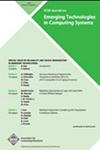特邀编辑导言:未来的片上网络架构(NoCArc)特刊
IF 2.6
4区 计算机科学
Q3 COMPUTER SCIENCE, HARDWARE & ARCHITECTURE
引用次数: 0
摘要
©1随着集成到同一集成电路中的核心数量的增加,作为通信基础设施的片上网络(NoC)的作用变得越来越重要。下一代多核处理器系统将继续面临与通信相关的可扩展性问题,而下一代硅技术节点引发的超深亚微米效应将进一步加剧这一问题。由加速器、量子计算、DNA计算存储技术和光计算组成的新型计算范式的出现,对互联的未来产生了深远的影响。集成平台,如中介器和内存处理,预计也会影响NoC研究的进程。此外,大数据、人工智能、深度学习和网络安全等应用也将影响NoC研究的未来。随着Dennard缩放的结束,大型多核处理器系统被分解成更小的芯片或小片,并使用传统平台(如板)以及新兴技术(如2.5D中间层、硅光子学(SiPh)或无线互连)进行集成。中间层是带有最少或没有有源器件的大型硅晶片,提供丰富的布线资源来互连集成在中间层插座上的片。由于具有最小的有源设备,并且仅使用长距离的全球有线互连,因此能够重用旧的更成熟的技术节点,这使得中间体成为低成本和可持续扩展平台的自然选择,这些平台不需要新材料,并且可以重用现有的制造节点。丰富的布线资源为扩展系统中的小芯片数量和研究新颖的、基于应用的包中网络(NiP)设计提供了新的机会,这些设计为设计人员提供了性能、能效、可靠性、可扩展性和可持续性方面的广泛权衡。SiPh作为片上和片对片互连技术正在成熟。使用微型环形谐振器,马赫-曾德尔调制器/解调器和波导,支持密集波分复用,其中多对发送者和接收器可以在芯片端尺寸上以超低延迟和提高的能源效率进行高带宽通信。更大密度下SiPh器件的集成和小型化以及消除电畴转换仍然是该领域的开放挑战。通过NoC或iP链路的多核系统中的核心之间的无线和射频通信可以通过每秒千兆比特的链路使用微型毫米波或次太赫兹提供延迟绑定通信。无线通信提供了对广播或多播流量的支持,这在多核处理器系统中是非常有益的,因为有必要的控制消息,如缓存一致性协议消息。通过消除重复的单播,本文章由计算机程序翻译,如有差异,请以英文原文为准。
Guest Editors Introduction: Special Issue on Network-on-Chip Architectures of the Future (NoCArc)
© 1 h s the number of cores integrated into the same integrated circuit increases, the role of the etwork-on-Chip (NoC)—as the communication infrastructure—becomes increasingly more imortant. Next-generation many-core processor systems continue to face communication-related calability problems, which are further exacerbated by ultra-deep sub-micron effects induced by he next silicon technology nodes. The emergence of novel computing paradigms consisting of ccelerators, quantum computing, DNA computing storage technologies, and optical computing an have deep and far-reaching implications on the future of interconnects. Integration platforms uch as interposers and processing-in-memory are also predicted to influence the course of NoC esearch. Furthermore, applications such as big data, artificial intelligence, deep learning, and cyersecurity will also impact the future of NoC research. With the end of Dennard scaling, large many-core processor systems are disaggregated into maller chiplets or dielets and are integrated using traditional platforms such as boards as well s emerging technologies such as 2.5D interposers, Silicon Photonics (SiPh), or wireless interonnects. Interposers are large silicon dies with minimum or no active devices providing abunant wiring resources to interconnect dielets integrated on sockets in the interposer. The capabilty to reuse older more mature technology nodes due to minimum active devices and the use of nly long-distance global wire-based interconnects make interposers a natural choice for low-cost nd sustainable scalable platforms that do not need new materials and can reuse existing fabriation nodes. The abundant wiring resources provide new opportunities for scaling the number f chiplets in the system and for research into novel, application-informed Network-in-Package NiP) designs that provide designers a wide range of tradeoffs in performance, energy efficiency, eliability, scalability, and sustainability. SiPh is maturing as an on-chip and chip-to-chip interconnect technology. Using miniature ring esonators, Mach-Zehnder modulator/demodulators, and waveguides, dense wavelength division ultiplexing is supported where multiple pairs of senders and receivers can communicate with igh bandwidth over chip-side dimensions with ultra-low latency and improved energy efficiency. ntegration and miniaturization of the SiPh devices at larger densities and elimination of electroptic domain conversions remain open challenges in this field. Wireless and radio frequency communication among cores in a many-core system over NoC or iP links can provide latency-bound communication using miniature millimeter-wave or sub-THz ands over multi-gigabit per second links. Wireless communication provides support for broadcast r multicast traffic, which is extremely beneficial in many-core processor systems due to essential ontrol messages such as cache coherency protocol messages. By eliminating repeated unicasts,
求助全文
通过发布文献求助,成功后即可免费获取论文全文。
去求助
来源期刊
CiteScore
4.80
自引率
4.50%
发文量
86
审稿时长
3 months
期刊介绍:
The Journal of Emerging Technologies in Computing Systems invites submissions of original technical papers describing research and development in emerging technologies in computing systems. Major economic and technical challenges are expected to impede the continued scaling of semiconductor devices. This has resulted in the search for alternate mechanical, biological/biochemical, nanoscale electronic, asynchronous and quantum computing and sensor technologies. As the underlying nanotechnologies continue to evolve in the labs of chemists, physicists, and biologists, it has become imperative for computer scientists and engineers to translate the potential of the basic building blocks (analogous to the transistor) emerging from these labs into information systems. Their design will face multiple challenges ranging from the inherent (un)reliability due to the self-assembly nature of the fabrication processes for nanotechnologies, from the complexity due to the sheer volume of nanodevices that will have to be integrated for complex functionality, and from the need to integrate these new nanotechnologies with silicon devices in the same system.
The journal provides comprehensive coverage of innovative work in the specification, design analysis, simulation, verification, testing, and evaluation of computing systems constructed out of emerging technologies and advanced semiconductors

 求助内容:
求助内容: 应助结果提醒方式:
应助结果提醒方式:


